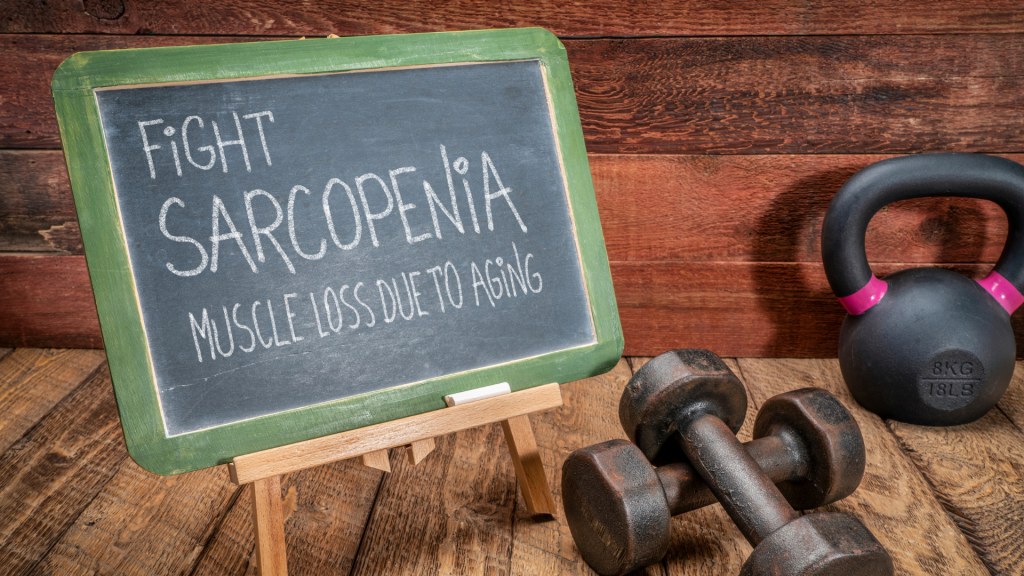Muscle Loss Impacts Women as They Age: What You Need to Know
As women age, they often encounter challenges with muscle loss, a condition known as sarcopenia. This process can be influenced by a variety of factors, ranging from hormonal changes to lifestyle choices and nutritional deficiencies. In this comprehensive blog, we cover crucial details about sarcopenia, offering invaluable insights into its causes, effects, and, most importantly, proactive measures to mitigate its impact – to empower women with the knowledge and tools they need to maintain their strength and vitality as they navigate through different stages of life.
What is sarcopenia?
Sarcopenia, a condition marked by the gradual loss of muscle mass as individuals age, significantly impacts one’s ability to perform everyday tasks such as lifting objects or walking comfortably. It affects both sexes equally, although studies regarding its prevalence among different ethnic groups vary.
In individuals aged 60 and older, the prevalence of sarcopenia ranges from 5% to 13%, with the likelihood of occurrence rising as age advances. Several research papers indicate that between 11% and 50% of individuals aged 80 and above grapple with this condition, underscoring the pressing need for intervention and support.
It’s worth noting that post-menopausal women are particularly vulnerable to sarcopenia, emphasizing the necessity for tailored healthcare strategies to address their unique needs.
What causes sarcopenia in women?
The prevalence rates of sarcopenia illustrate a concerning reality: among individuals aged 60 and older, estimates range from 5% to 13%, and this figure escalates dramatically to 11% to 50% among those aged 80 and beyond. Understanding the underlying causes behind the loss of muscle mass sheds light on this complex condition.
Hormonal Changes:
– Estrogen and progesterone decline: Menopause heralds the cessation of the menstrual cycle, accompanied by a significant decrease in estrogen and progesterone levels. These hormones, vital for reproductive health, also play crucial roles in maintaining muscle health. Estrogen fosters muscle growth and inhibits protein breakdown, while progesterone aids in muscle maintenance, although it’s less extensively studied. The decline in estrogen levels during menopause correlates with sarcopenia, the age-related decline in muscle mass and function. Moreover, these hormones influence insulin sensitivity, inflammation, and mitochondrial function, all impacting muscle health. Nonetheless, sarcopenia stems from a multitude of factors, with age, physical activity, and nutrition also exerting substantial influence.
– Testosterone reduction: Although primarily known as a male hormone, testosterone also contributes to women’s muscle maintenance and strength. Despite lower levels in women compared to men, testosterone still supports muscle protein synthesis and maintenance. The declining levels of testosterone in women, particularly during and after menopause, can influence sarcopenia, underscoring its multifaceted nature.
Lifestyle and Habits:
– Sedentary lifestyle: Lack of physical activity or prolonged periods of sitting are significant contributors to sarcopenia in women. Irrespective of age, women need to engage in regular exercise to maintain fitness and strength.
– Poor nutrition: Inadequate protein and vitamin intake contribute to muscle mass loss in women.
– Bone health issues: Menopause often brings forth osteoporosis, characterized by weakened and brittle bones, primarily due to insufficient calcium intake. Osteoporosis impairs women’s mobility and correlates with muscle loss.
While sarcopenia may not be entirely preventable, individuals can preserve muscle strength through a combination of proper nutrition and exercise. By prioritizing these proactive measures, individuals can enhance their quality of life and maintain independence as they age.
What exercises can help prevent sarcopenia?
Sarcopenia, the age-related decline in muscle mass and strength, need not be an inevitable part of ageing. By embracing a regimen of regular exercise, we can not only mitigate its effects but also potentially prevent its onset. Here are several types of exercises that can serve as powerful allies in the fight against sarcopenia:
- Resistance Training: Utilize weights, resistance bands, or your own body weight to challenge your muscles. Incorporate exercises such as squats, lunges, push-ups, and rows to target major muscle groups effectively.
- Strength Training: Focus on enhancing muscle strength rather than just size. Lift heavier weights with fewer repetitions to build strength efficiently.
- Weight-bearing Exercises: Engage in activities like walking, jogging, hiking, and stair climbing to bear your body weight, maintaining both bone density and muscle mass.
- Balance and Stability Exercises: Prioritize exercises that enhance balance and stability to prevent falls, especially crucial for older adults. Consider yoga, tai chi, or core-strengthening exercises.
- Flexibility and Stretching: Maintain joint flexibility and range of motion through stretching exercises, promoting overall mobility and reducing injury risk.
- Functional Training: Integrate exercises mimicking daily movements to enhance functional ability, such as lifting groceries or getting up from a chair.
- High-Intensity Interval Training (HIIT): Incorporate short bursts of intense activity followed by rest or lower intensity to improve muscle mass and function effectively.
- Endurance/Cardiovascular Exercise: While not directly targeting muscle mass, aerobic activities like walking, cycling, swimming, or dancing are vital for overall health and complement resistance training efforts.
Remember, alongside exercise, nutrition plays a pivotal role in combating sarcopenia. By nourishing your body with a balanced diet rich in protein and essential nutrients, you provide the foundation necessary for optimal muscle health and vitality. Together, exercise and nutrition form a powerful duo in your quest for strength and longevity.
What nutrients help in preventing sarcopenia?
Nutrition is a cornerstone in the battle against sarcopenia, with several key nutrients playing pivotal roles in supporting muscle health and function. Here’s a breakdown of essential nutrients to prioritize:
- Protein: The bedrock of muscle maintenance and growth, ensure sufficient intake from lean meats, fish, eggs, dairy, legumes, and tofu.
- Essential Amino Acids: These building blocks of protein are vital for muscle synthesis, found abundantly in animal proteins and plant-based sources like quinoa, soy, and buckwheat.
- Leucine: A standout among essential amino acids, leucine stimulates muscle protein synthesis and is readily available in meat, dairy, soybeans, and lentils.
- Vitamin D: Crucial for muscle strength and bone health, attain vitamin D through sunlight exposure, fortified foods, and supplements if needed.
- Calcium: Indirectly supporting muscle function via bone health, calcium-rich foods include dairy, leafy greens, fortified plant-based milks, and certain fish varieties.
- Omega-3 Fatty Acids: With anti-inflammatory properties, omega-3s bolster muscle health, found in fatty fish, flaxseeds, chia seeds, and walnuts.
- Magnesium: Essential for muscle contraction and relaxation, magnesium-rich foods comprise nuts, seeds, whole grains, leafy greens, and legumes.
- Antioxidants: Combatting oxidative stress, antioxidants abound in fruits, vegetables, nuts, seeds, and spices like turmeric and cinnamon.
- Creatine: Fueling muscle contractions, creatine supports strength and mass, sourced from meat, fish, or supplements.
- B-vitamins: Vital for energy metabolism and muscle health. Obtain B6, B12, and folate from meat, fish, poultry, eggs, dairy, greens, and fortified cereals.
By incorporating these nutrient powerhouses into your diet, you lay a robust foundation for maintaining muscle health and vitality, empowering yourself to combat sarcopenia and embrace a life of strength and resilience.
In conclusion,
As women age, the spectre of sarcopenia looms, threatening to diminish their strength and vitality. Yet, armed with knowledge and proactive measures, this need not be their fate. By embracing a suitable exercise regimen and prioritizing proper nutrition, women can fortify their bodies against the ravages of muscle loss. From resistance training to essential nutrient intake, every step taken is a stride towards maintaining independence and resilience through the stages of life.
My Mother, My Mitr.
Dear Mothers,
From complimentary nutrition consultations to physiotherapy assessments and even five free days at Gold’s Gym, we ensure that no obstacle stands between you and your wellness goals. Together, let us embark on this transformative journey, where every step forward is supported by a community dedicated to your thriving vitality.


